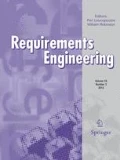Abstract
Requirements engineering practice in industry is often encumbered by practical limits of time, resource, and attention. In our environment, most requirements authors have had no formal training in the practice, yet are expected to produce high-quality specifications that drive subsequent work. Authors are often unaware of different techniques for requirements specification and are rarely equipped to navigate all of the techniques and tools that are potentially available to them, to the extent that they are even aware of the various options. A small cadre of coaches, providing focused, just-in-time mentoring of authors in a handful of basic techniques can increase the proficiency of these authors, who in turn produce higher-quality requirements specifications. From this foundation, authors may be able to later adopt additional techniques to further improve the quality and maturity of their work, thus resulting in improved work products built on the basis of those specifications.
Similar content being viewed by others
Notes
The checklist chosen and in use within the company is a lightweight set of criteria designed for easy comprehension and transferability and serves to establish a shared taxonomy of major categories of defects.
Requirements defects are quantified using a “defect per page” (DPP) metric. Gilb, in Competitive Engineering [3], specifies a logical page as 300 non-commentary words. The particular program in this discussion calculated a logical page at 400 words.
These defect counts represent data from the tailored version of Gilb’s Specification Quality Control in use with the RAMP program. In most cases, reviews and defect counts were conducted by a single reviewer working with an author, using the specific checklist in use within the company, and without controls on the review reading rate. Additional and more experienced reviewers (typically n = 3) and a more formal inspection process would be expected to lead to both a higher initial defect count and more potential defects identified post-mentoring as well.
References
Terzakis J, Gregory S (2016) RAMP: requirements authors mentoring program. In: Proceedings of the 24th international requirements engineering conference (RE’16), pp 323–328
Mavin A, Wilkerson P (2009) EARS (Easy Approach to Requirements Syntax). In: Proceedings of the 17th international requirements engineering conference (RE’09), pp 317–322
Gilb T (2005) Competitive engineering: a handbook for systems engineering, requirements engineering, and software engineering using planguage. Butterworth-Heinemann, Oxford
Author information
Authors and Affiliations
Corresponding author
Rights and permissions
About this article
Cite this article
Gregory, S.C., Terzakis, J. Viewpoint: effectiveness of focused mentoring to improve requirements engineering industrial practice. Requirements Eng 22, 413–417 (2017). https://doi.org/10.1007/s00766-017-0269-7
Received:
Accepted:
Published:
Issue Date:
DOI: https://doi.org/10.1007/s00766-017-0269-7




